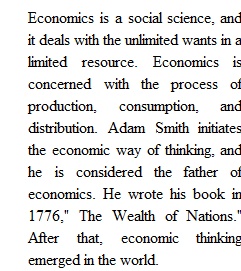


Q Define Economics: 2. How many factors of production are there? Name them: 3. What are the Key Economic Questions? (enter number) List them: 4. The Economic way of thinking was created by whom and when? 5. Briefly explain the difference between Macroeconomics and Microeconomics
Q 1. Principle of Opportunity Cost, no matter what we do, there will always be a trade-off. True or False? 2. What is the difference between Marginal benefit and Marginal cost? Provide an example of something other than what's in the textbook. 3. Provide an example for the Principle of Voluntary Exchange other than the one in the book. 4. The Principle of Diminishing returns is relevant when what happens? 5. What matters to people is the real value of money or income, and its purchasing power, not its face value, is called what?
Q 1. Describe and explain the law of demand: 2. Individual Demand Curve - What variables can affect an individual consumer's decision when purchasing a product or service? 3. Describe and explain the law of supply: 4. The minimum supply price is the (enter HIGHER or LOWER) price at which a product is supplied. 5. As the market reaches an equilibrium, there is always pressure to change the price. True or False?
Q 1. To compute the price elasticity of demand, we divide the percentage change in (what?) by the percentage change in (what?) and then take the value of the ratio. 2. If a 10 percent increase in price, decreases the quantity demanded by 12 percent, the price elasticity of demand is: 3. When the price of CDs increased from $10 to $11, the quantity of CDs demanded, decreased from 100 to 80. The price elasticity of demand for CDs is , and demand is what? 4. Demand is Elastic or Inelastic? (choose one) on the upper portion of a linear demand curve and revenue Increases or Decreases? (choose one) on the lower portion of a linear demand curve. 5. When the price of paper increases from $100 to $104 per ton, the quantity supplied increases from 200 to 220 tons per day. The price elasticity of supply is what?
Q 1. Distinguish the difference between economic cost and economic profit: 2. What is an opportunity cost that does not involve a monetary payment? 3. Briefly explain what (FC), (VC), and (TC) stand for and what the formula is for short-run cost (explain) and provide an example: 4. Explain the difference between what Economies of Scale and Diseconomies of scale is: 5. Once the minimum efficient scale has been reached, the average cost no longer decreases as output increases is called?
Q 1. In a perfectly competitive market, hundreds or even thousands of firms sell a homogeneous product. True or False? 2. How many features are there to be considered a Perfectly Competitively Market? List them: 3. Briefly explain the differences between Monopoly, Monopolistic Competition and Oligopoly: 4. Explain the shut-down rule: 5. The short-run supply curve is steeper than the long-run supply curve because of the principle of:
Q 1. What are some of the trade-offs associated with a patent? List them: 2. How many years does an inventor have the exclusive right to sell a product? 3. Provide an example of a natural monopoly: 4. Describe the practice of price discrimination: 5. Price discrimination is not a good thing, so provide three examples of this what are considered bad practices for this type of behavior: 6. The trade-off with entry is that an increase in the number of firms leads to higher what? but also greater what?:
Q 1. Monopolistic competition refers to a market in which old boys act naturally as they transport tight slacks in the back of Dodge Ram pickup trucks. True or False? 2. Perfectly competitive firms sell what type of product? , while monopolistically competitive firms sell a what type of product? 3. The trade-off with entry is that an increase in the number of firms leads to higher what? but greater what? 4. There are how many types of antitrust policies? , what are they? 5. The purpose of an antitrust policy is to promote what? which leads to lower what?
View Related Questions